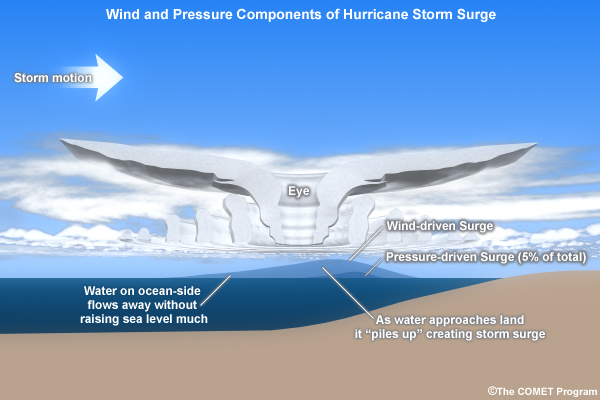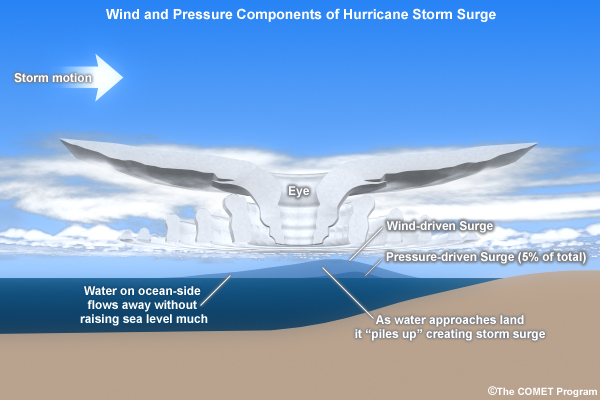Storm surges provoke increasing interest in relation to catastrophic occurrences and their damage in coastal and estuarine areas as the physical processes presently observed jeopardize coastal life. Notably, Global Warming raises the danger of coastal flooding caused by multiple phenomena (Rahmstorf, 2017). For instance, the Atlantic hurricane season in 2017 resulted in almost unprecedented damage as Hurricane Irma maintained category five according to Saffir–Simpson scale for especially log time (Rahmstorf, 2017). Although storm surges are not the only danger that climate change accentuates, they are significant for the global community’s well-being. With climate change rendering hurricanes more deadly, it is essential to gain a more in-depth understanding of such phenomenon as storm surge. It is also significant to ensure that accurate and prompt forecasting systems are available in the most vulnerable zones.
Defining the notion from the outset helps gain a more in-depth understanding of its nature and mechanisms. Thus, storm surges constitute one of the numerous variables used to characterize the dynamic state of oceans and seas (Wu et al., 2018). More precisely, a storm surge is described as “the abnormal sea level variation forced by wind stress and sea level pressure gradients over the sea surface” (Ji and Li, 2019, p. 301). The mechanisms of storm surge formation can be seen in Figure 1 (National Weather Service, 2020). The phenomenon is also known under the name of ” meteorological residuals” or “meteorological tides.” In combination with waves and tidal oscillations, it is a primary contributor to elevated water levels in the zones bordering the shoreline (Ji and Li, 2019). Such territories more frequently experience damaged infrastructure, loss of human life, and biodiversity caused by flooding resulting from elevated water levels. In its turn, the flooding is typically a result of a combination of multiple factors, among which are high storm surges.

In recent decades understanding of storm surges and predictive models has considerably improved. Currently, storm surge forecasting systems became integrated into more countries. The systems can issue forecasts in real-time and became large-scale (Khan et al., 2020). Although storm surge systems consist of somewhat straightforward and well-established physics, detailed forecasts have higher requirements. In order to be accurate, storm surge forecasting systems need “TC condition (predictions and forecasts) as input, reasonable storm surge predictions (with forecasting systems), and effective advisories/warnings (i.e., useful information products)” (Kohno et al., 2018, p. 128). Such systems’ performance is determined by the quality of data regarding relevant processes (waves, tides, surges, and their interactions) and wind and atmospheric pressure forcing (Khan et al., 2020). Typically, mistakes related to wind and atmospheric pressure forcing impede accurate storm surge forecasting. As a result, for enhanced reliability, input, forecasting systems, and efficient data should be ameliorated systematically.
Storm surge forecasting and modeling are of supreme significance in the North Sea region. This region is particularly vulnerable because of the low-laying territories bordering the sea. For instance, the flood of 1953 was a disastrous event heavily affecting countries situated along it (Garnier et al., 2020). Advanced storm surges forecasting systems can alleviate the danger in the region. Presently, pan-European Storm Surge Forecasting enhances storm surge predictive capability along the North Sea (Fernández-Montblanc et al., 2019). The system led to a 2% reduction in RMSE (the inaccuracy of a model in forecasting), which is a considerable improvement for the region (Fernández-Montblanc et al., 2019). The superior performance permits to record the tidal dynamics and surges propagation in the area under consideration. In addition to the Europe-Wide forecasting, countries along the North Sea have their operational systems. For instance, the system protecting the German North Sea coastline consists of weather forecast systems, a surge model, and model output statistics (Niehuser. et al., 2018). It can be seen that storm surge forecasting operates extensively along the North Sea.
In the North Adriatic Sea, water level abnormalities are not exceptional. The area suffers from astronomical tides, seiches, storm surges, relative sea level rises, and others (Lionello et al., 2020). These phenomena do not have the same impact on how they contribute to extreme water level events and coastal inundations (Zampato et al., 2016). These events are mostly caused by large storm surges, while other water level abnormalities contribute only slightly, which can be seen in Table 1 (Lionello et al., 2020). Regarding Venice, low tides are typical for the city as it is flooded several times a year when the Adriatic Sea tide rises, with the first such instance registered in 782 AD (Garnier, 2018). While low tides are ordinary for Venice, storm surges causing extreme sea levels are less habitual in the territory as the frequency with which they occur accelerated only during this century given the climate change. Hence, the contradiction can be explained by the fact that high tides and storm surges are less typical and more dangerous as the height of water they bring is drastically different from low tides.

In terms of damage caused by extreme sea levels, similarly to countries along the North Sea, Hong Kong is particularly vulnerable. The city is projected to be among the top 50 urban zones at risk of future flood losses (De Dominicis et al., 2020). The projection is partly based on the city’s geography: situated on Southern China’s coast, the city experiences the effects of tropical cyclones, significantly raising water levels. Hence, storm surges are a frequent problem in this urban area, causing severe damage, which is seemingly amplified in the forthcoming years due to the rising global mean water level (Jilong, 2020). Similar to the North Sea territories, storm surge monitoring and prediction in Hong Kong cannot be overestimated for the well-being and protection of the local community.
Despite the equal implications, storm surges in Hong Kong and the North Sea have a somewhat different nautre. While in Hong Kong, their leading cause is tropical cyclones, in the North Sea, storm surges result from hurricane-force winds and several accidental factors in combination with the territory’s meteorological peculiarities (Jilong, 2020). Ultimately the cause of storms in the two territories is comparable, as low pressure and strong winds are necessary for both tropical cyclones and storms (Ji and Li, 2019). The purpose of forecasting systems in these territories can be reduced to detection and reaction to the forthcoming danger as promptly as possible.
In conclusion, storm surges are complex natural phenomena, the effect of which the current state of climate aggravates. Large coastal areas suffer from storm surges, including the territories along North Adriatic Sea, the North Sea, and such massive urban regions as Hong Kong. Although the nature of storm surges is slightly different there, its dangers appear almost equally high. The potential damage of storm surges accentuates the need for accurate and fast forecasting systems. They are systematically developed and show consistently improving accuracy even in real-time reporting, bringing hope to coastal areas.
Reference List
De Dominicis, M. et al. (2020) Future interactions between sea level rise, tides, and storm surges in the world’s largest urban area. Geophysical Research Letters, 47(4), e2020GL087002.
Fernández-Montblanc, T. et al. (2019) Towards robust pan-European storm surge forecasting. Ocean Modelling, 133, pp.129-144.
Garnier, E. et al. (2018) Historical analysis of storm events: case studies in France, England, Portugal and Italy. Coastal Engineering, 134, pp.10-23.
Ji, T. and Li, G. (2019) Contemporary monitoring of storm surge activity. Progress in Physical Geography: Earth and Environment, 44(3), pp.299-314.
Jilong, C. (2020). Impacts of climate change on tropical cyclones and induced storm surges in the Pearl River Delta region using pseudo-global-warming method. Scientific Reports, 10, pp.1-10.
Khan, M. et al. (2020) Towards an efficient storm surge and inundation forecasting systemover the Bengal delta: chasing the super-cyclone Amphan. Natural Hazards and Earth System Sciences, pp.1-29.
Kohno, N. et al. (2018) Recent progress in storm surge forecasting. Tropical Cyclone Research and Review, 7(2), pp.128-139.
Lionello, P. et al. (2020) Extremes floods of Venice: characteristics, dynamics, past and future evolution. Natural Hazards and Earth System Sciences, pp.1-34.
National Weather Service (2020). About storm surge. Web.
Niehuser, S. et al. (2018) A novel high-resolution storm surge forecast for the German bight. Coastal Engineering Proceedings, 36, p.80.
Rahmstorf, S. (2017) Rising hazard of storm-surge flooding. Proceedings of the National Academy of Sciences, 114(45), pp.11806-11808.
Wu, W., et al. (2018) Mapping dependence between extreme rainfall and storm surge. Journal of Geophysical Research: Oceans, 123(4), pp.2461-2474.
Zampato, L. et al. (2016). Storm surge modelling in Venice: two years of operational results. Journal of Operational Oceanography, 9(1), pp.46-57.